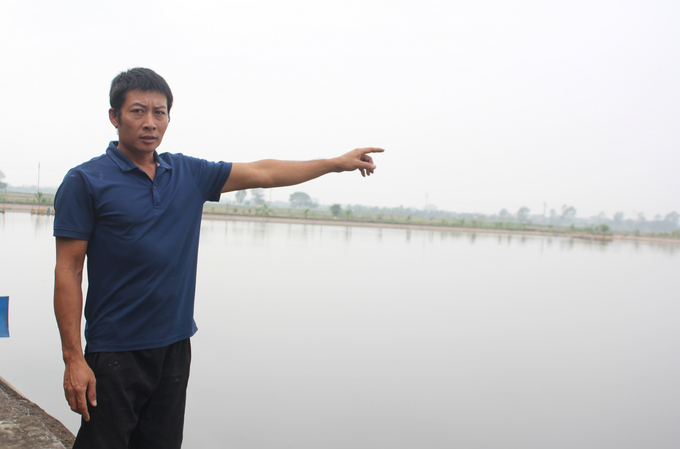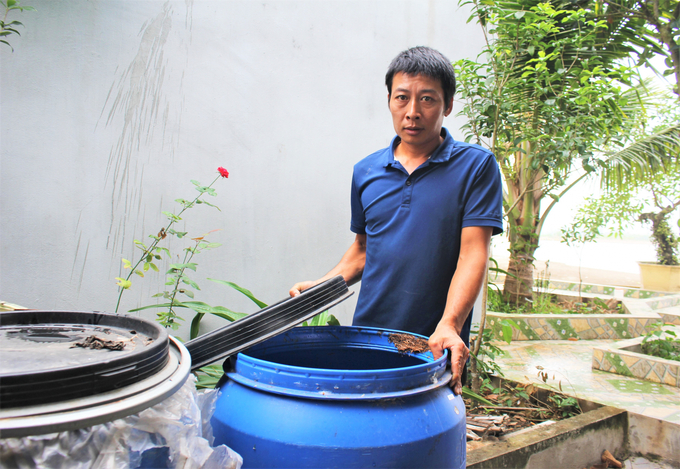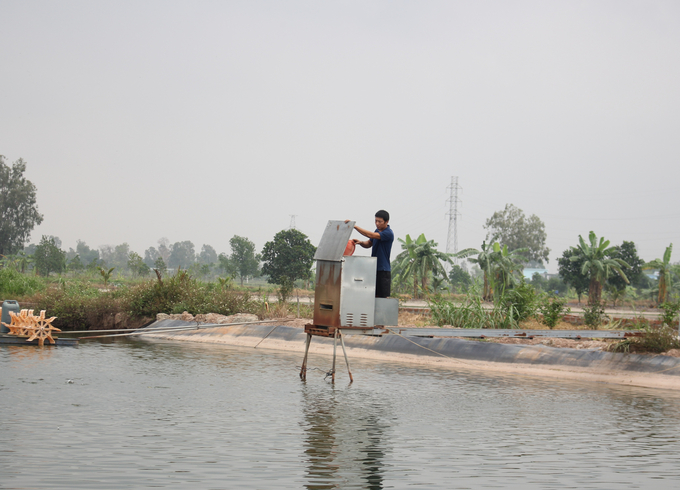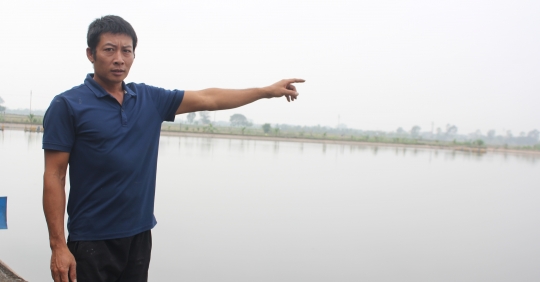Don’t break the soil of rice land
In recent years, in addition to the development of aquaculture in traditional ponds, the Thai Binh have developed a number of fish farming models in semi-floating ponds with very positive economic results.
Mr. Lai Van Hoa from Tuong An Village in Tan Hoa Municipality (Vu Thu, Thai Binh), after a period of traveling and working enough to earn a living, noticed that the land near people’s homes for the Rice cultivation inefficient was longer worked in agriculture because they have moved to work in factories and companies; Also, the number of borrowed, uncultivated fields gradually increased, he boldly accepted a contract for 8 hectares to grow rice in combination with fish farming.

Mr. Lai Van Hoa, Tuong An Village, Tan Hoa Township (Vu Thu, Thai Binh) has had success with the semi-floating pond fish farming model. Picture: Life.
By 2017, he stopped growing rice, renovated the entire area and built a semi-floating pond to focus on industrial fish farming.
Mr Hoa said raising fish in semi-floating ponds has more advantages than raising fish in traditional underwater ponds. Specifically, the ponds are designed and arranged to float in the center of the field, reducing the cost of making ponds by about 40%. As the pond sinks deeper, digging requires much labor and takes up an area for storing soil, while a floating pond only needs to dig 30~50cm deep and then take a layer of fertile soil to cover the shore with 1, 5 to fill – 2m high in use, convenient for expansion and area expansion when needed.
Not digging deep also helps the pond keep the pond bottom firm and flat, less dredging of mud, very convenient for harvesting and cleaning the pond bottom.
Mr. Hoa shared: High-density industrial farming, the amount of feed used for 1 litter is very large, so there are a lot of leftover feed and fish waste. So if the pond bottom is firm and level, the water is drained completely and then dried, it is possible to eliminate all debris in the pond. From there, reduce pathogens, save labor costs, healthy fish growth and development. In particular, the floating pond preserves the original state of the land, so that the rice planting area can be properly restored if necessary.

Anh Hoa soaks garlic and mixes it with feed to increase fish resistance without using antibiotics. Picture: Life.
Another advantage of semi-floating ponds according to Mr. Hoa is that the water surface is increased, the ability to catch light and wind is higher than that of submerged ponds; many waves, good ventilation, suitable for high-density farming.
In addition, the semi-floating pond fish farming method is simple, can use the system of water supply and drainage canals for rice production to serve aquaculture, save investment costs, fight disease and achieve high economic efficiency. At the same time, it is possible to overcome the situation that farmers leave their fields fallow or spontaneously change, fragment and disturb the cultivation soil.
“Say no” to antibiotics
Mr. Lai Van Hoa said: The advantages of semi-floating ponds are clear, but for successful fish farming, the factors of seed, nutrition, disease prevention and treatment, etc. still need to be ensured.
In terms of seed, this is the key factor that accounts for 70% of success in fish farming. Instead of importing as initially, Mr. Hoa now has 2 breeding ponds, both of which help to control the supply and quality of the seeds.
“In the past, it was far from buying seed, so fish scratched it during transportation, creating conditions for fungal invasion, while the disease rate, mortality rate and loss were enormous. Now self-sufficiency and transplanting to ponds takes very little time to complete a litter, saving labor costs and purchasing prices. The juveniles are guaranteed to be safe and adapt quickly to the ponds,” said Mr. Hoa.

Mr. Hoa’s model of intensive tilapia farming in semi-floating ponds yields a profit of VND 7,000/kg of fish. Picture: Life.
To prevent and treat fish diseases, Mr. Hoa’s water source is carefully treated with organic products before it is added to the pond. After the fish harvest, the pond is drained and dried for about 20 days to kill pathogens. In addition, the sanitary treatment of ponds is carried out regularly, regularly using powdered lime in the amount of 2 kg / 100 m2 every 15 days.
In particular, Mr. Hoa’s whole pond does not use antibiotics, instead he grinds garlic, soaks it in sugar and vinegar (according to the recipe 10 kg of garlic, 16 liters of water, 1 kg of sugar, 1 liter of vinegar ) blender with industrial feed 2-3 times/ Feed for a week to increase the fish’s resistance.
“Speaking of disease prevention and treatment in fish, adding garlic to food to increase resistance is much better than using drugs because if you use too many antibiotics, the fish will grow slowly and have a lot of residues on the product,” confirmed whoa .
In terms of profitability, Mr. Hoa said: Tilapia breeding in the industry is very expensive, especially for food. Counting over 100 tons of fish, it is about VND 2.4 billion for food (VND 25,000/kg) at the time of harvest. However, with the advantage of high density, the economy is not low.
On average he sells 2 litters of meat fish at the market with a production of 160 tons per year per juvenile. Recently, he just sold 70 tons of tilapia with a retail price of 33,000-34,000 VND/kg, after deducting expenses, he has a profit of 7,000 VND/kg.

